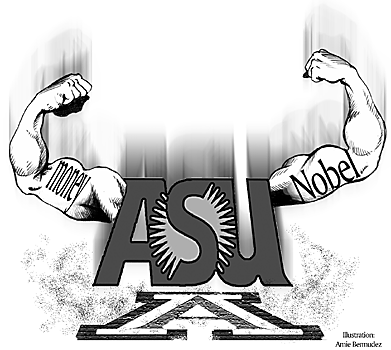
Illustration by Arnie Bermudez
|
|
By Ryan Johnson
Arizona Daily Wildcat
Thursday, October 28, 2004
Print this
The two scenarios are strikingly similar.
A renowned economics professor, on the cusp of winning the Nobel Prize, the highest award in academia, leaves his long-time home for another school.
A year later he wins the award, making his former institution look unprepared, under-funded and outwitted. Meanwhile, the professor's new home gets bragging rights, attention and prestige.
This scenario has played out twice in the last three years. Unfortunately, the UA was on the losing end while this month Arizona State University found itself on the winning end.
In 2001 Vernon Smith, the "father" of experimental economics, which integrates psychology and economics, left the UA after more than 25 years to go to George Mason University. Colleagues had been anticipating his Nobel since the '80s, but the UA was unable to hold onto him. In 2002, he won the award.
Critics called it "brain drain," lack of planning and a crisis.
I prefer just "sucky."
On the other side of the coin, in 2003 ASU lured renowned macroeconomic scholar Edward Prescott away from the University of Minnesota with energetic recruiting and a lack of Minnesota winters.
Like George Mason, ASU had on its hands a sure bet.
Economists have called his work, which focuses on business cycles and time inconsistencies of government policies, easily deserving of the Nobel Prize.
Indeed, in an online betting market in which participants wager on who will win the Nobel Prize, Prescott easily had the lead, with a bet on him costing twice as much as any other economist.
Then this month what was anticipated became reality. Once he won, ASU immediately had its name in countless newspapers, magazines, journals and television shows.
Perhaps they got lucky, or perhaps they learned from the UA's mistake.
Granted, keeping top professors is difficult. Once a professor has accumulated a body of work as accomplished as Smith or Prescott, he or she can make all kinds of demands on university administrators. A big raise, more research space, cherry oak furniture.
Sometimes, professors even have serious grant money behind them. In 2003 a group of four science researchers proved they weren't bluffing the UA when they left for Georgia Tech, taking more than $10 million in grant money with them.
But then again, sometimes administrators simply clash with the professors. Smith showed he wasn't about the money when he promised to donate all $500,000 plus from his Nobel Prize to his research foundation. His bigger complaint? Lack of research support.
After the fiasco happened, he told the Wildcat one thing that sticks out in his mind was when he wanted to use an unoccupied room that had nothing but desks in it for his cutting-edge research. The administrators didn't cooperate and didn't seem to pay much attention to the request at all.
I can imagine administrators in their offices kicking themselves for ignoring his pleas.
What's ironic is that much of what Smith advocated, such as allowing individual colleges to differentiate more, is now happening at the UA. The Eller College of Management, for one, has raised its tuition to help retain and hire faculty.
And though Smith's departure weakened the economics department, it certainly wasn't the start of the brain drain. The economics department had already been reduced to half the size it was at its peak. Major departments nationwide have 50 professors, but UA had been lingering in the teens, forcing it to have only a miniscule macroeconomics component.
The Eller College also had been losing faculty for years. Between 1989 and 1996, it lost (in gross terms) 116 faculty members, including 80 tenured positions.
And Smith's departure left the economics department down, but not out. Although it has continued to lose faculty, some to retirement, it has replaced them with young, energetic hires. Now it actually has the same number of professors it had the year Smith left.
And don't for a minute tell James Cox, Smith's replacement as head of UA's Economic Science Laboratory, that the ESL died when Smith left. Cox, a well-known experimental economist in his own regard, has forged ahead, including implementing the successful EconPort, an online microeconomics curriculum project.
But still, ASU one-upping the UA in academics? It can't be.
And the Nobel Prize certainly wasn't the first time that ASU has looked mighty impressive lately.
Besides hosting a presidential debate and going forward with a downtown Phoenix campus, it has racked up an impressive series of private contributions. Fifty million dollars for their business school, $50 million more for their engineering school, $4.5 million for entrepreneurship programs.
Will the UA always be the academically superior institution?
Gosh, I hope so.
Ryan Johnson is an economics and international studies junior. He can be reached at letters@wildcat.arizona.edu.
